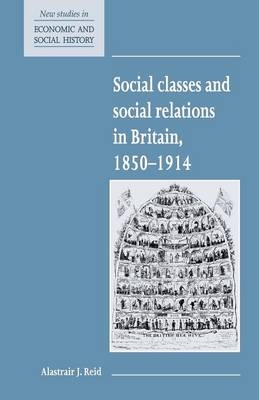
Social Classes and Social Relations in Britain 1850–1914
Seiten
1995
Cambridge University Press (Verlag)
978-0-521-55775-7 (ISBN)
Cambridge University Press (Verlag)
978-0-521-55775-7 (ISBN)
This book, first published in 1995, is a clear guide to the debates surrounding British social history between 1850 and 1914. It gives an account of how interpretations in the field have developed since the 1960s and highlights the strengths and weaknesses of each approach.
The analysis of social classes and social relations in the second half of the nineteenth century has caused major debates among social historians. In this book, first published in 1995, Alastair Reid provides a critical summary of the different approaches to the subject, giving an account of how interpretations have developed since the 1960s, and highlighting the strengths and weaknesses of each approach. The author explains how the influence of social sciences in the 1960s led scholars to emphasise the rise to power of the bourgeoisie, and the increasing subordination of the industrial working class. Recently more detailed research has led to a return to the older historical emphasis on the persistence of aristocratic power, the increasing independence of the working classes, and the centrality of voluntary agreement in a social order based on consent. The conclusion suggests new ways in which the subject might be approached. A select bibliography allows the reader to pursue the topic in more detail.
The analysis of social classes and social relations in the second half of the nineteenth century has caused major debates among social historians. In this book, first published in 1995, Alastair Reid provides a critical summary of the different approaches to the subject, giving an account of how interpretations have developed since the 1960s, and highlighting the strengths and weaknesses of each approach. The author explains how the influence of social sciences in the 1960s led scholars to emphasise the rise to power of the bourgeoisie, and the increasing subordination of the industrial working class. Recently more detailed research has led to a return to the older historical emphasis on the persistence of aristocratic power, the increasing independence of the working classes, and the centrality of voluntary agreement in a social order based on consent. The conclusion suggests new ways in which the subject might be approached. A select bibliography allows the reader to pursue the topic in more detail.
List of tables; Acknowledgment; Note on references; 1. Introduction; 2. The ruling classes; 3. The working classes; 4. Social relations; 5. Conclusions; Select bibliography; Index.
| Erscheint lt. Verlag | 28.9.1995 |
|---|---|
| Reihe/Serie | New Studies in Economic and Social History |
| Zusatzinfo | 5 Tables, unspecified |
| Verlagsort | Cambridge |
| Sprache | englisch |
| Maße | 140 x 216 mm |
| Gewicht | 120 g |
| Themenwelt | Geschichte ► Teilgebiete der Geschichte ► Kulturgeschichte |
| Geschichte ► Teilgebiete der Geschichte ► Sozialgeschichte | |
| Sozialwissenschaften ► Soziologie ► Makrosoziologie | |
| ISBN-10 | 0-521-55775-5 / 0521557755 |
| ISBN-13 | 978-0-521-55775-7 / 9780521557757 |
| Zustand | Neuware |
| Haben Sie eine Frage zum Produkt? |
Mehr entdecken
aus dem Bereich
aus dem Bereich
der stille Abschied vom bäuerlichen Leben in Deutschland
Buch | Hardcover (2023)
C.H.Beck (Verlag)
23,00 €
vom Mittelalter bis zur Gegenwart
Buch | Softcover (2024)
C.H.Beck (Verlag)
12,00 €
Die Revolution des Gemeinen Mannes
Buch | Softcover (2024)
C.H.Beck (Verlag)
12,00 €


